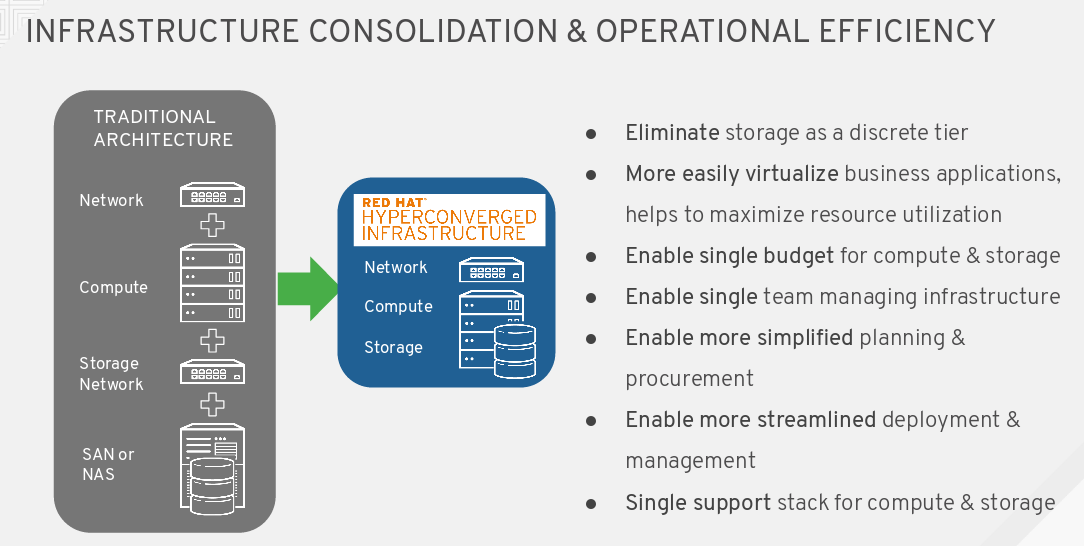This is the third post in Red Hat's three part series on open virtualization. Read the first post here and the second post here.
As organizations optimize and modernize their primary datacenters, they also must plan for how the infrastructure at their remote sites will be optimized and modernized as well. Remote and branch offices, however, can have unique infrastructure challenges: applications at these remote sites need local compute and storage, space and power/cooling can be very constrained or limited and fewer (or no) technical staff are typically onsite, to name just a few. Modernizing these sites often exposes and intensifies these challenges, making more simplified infrastructures at these remote offices an important consideration to help ease budgetary and staffing burdens.
Problems like these could benefit from a hyperconverged solution, a technology seeing increased use for remote and branch office deployments. Hyperconvergence, where discrete software tiers can now delivered on a single server, can address many of the challenges introduced by remote sites through consolidating compute and storage, helping to simplify planning and procurement as well as management with a single solution from one vendor. The image below illustrates this consolidation as well as the benefits.

Red Hat Virtualization has been shown to yield benefits of it own - a recent Forrester Total Economic Impact (TEI) Study commissioned by Red Hat highlights the benefits of Red Hat Virtualization. These benefits, when added to those of hyperconvergence as mentioned above, can make a compelling case!
Built on Red Hat Virtualization and Red Hat Gluster Storage, Red Hat Hyperconverged Infrastructure is designed to provide more simplified planning and procurement, better streamlined deployment and management, and a single support stack for virtual compute and virtual storage resources. Red Hat Hyperconverged Infrastructure is designed to be an effective solution for remote/ branch-office or edge computing needs. Deployment is enabled by Ansible by Red Hat, and Red Hat CloudForms can be used to manage all the Red Hat Hyperconverged Infrastructure installations in your enterprise via a single application.
For more information:
- Learn more about optimizing your IT with open virtualization and storage.
- Read a whitepaper sponsored by Red Hat about reducing the costs of proprietary virtualization.
- Watch webinars on moving to modern IT infrastructure and speeding virtualization deployments with Ansible.
Über die Autoren
Red Hat is the world’s leading provider of enterprise open source software solutions, using a community-powered approach to deliver reliable and high-performing Linux, hybrid cloud, container, and Kubernetes technologies.
Red Hat helps customers integrate new and existing IT applications, develop cloud-native applications, standardize on our industry-leading operating system, and automate, secure, and manage complex environments. Award-winning support, training, and consulting services make Red Hat a trusted adviser to the Fortune 500. As a strategic partner to cloud providers, system integrators, application vendors, customers, and open source communities, Red Hat can help organizations prepare for the digital future.
Mehr davon
Nach Thema durchsuchen
Automatisierung
Erfahren Sie das Neueste von der Automatisierungsplattform, die Technologien, Teams und Umgebungen verbindet
Künstliche Intelligenz
Erfahren Sie das Neueste von den Plattformen, die es Kunden ermöglichen, KI-Workloads beliebig auszuführen
Cloud Services
Mehr erfahren über Managed Cloud Services
Sicherheit
Erfahren Sie, wie wir Risiken in verschiedenen Umgebungen und Technologien reduzieren
Edge Computing
Erfahren Sie das Neueste von den Plattformen, die die Operations am Edge vereinfachen
Infrastruktur
Erfahren Sie das Neueste von der weltweit führenden Linux-Plattform für Unternehmen
Anwendungen
Entdecken Sie unsere Lösungen für komplexe Anwendungsherausforderungen
Original Shows
Interessantes von den Experten, die die Technologien in Unternehmen mitgestalten
Produkte
- Red Hat Enterprise Linux
- Red Hat OpenShift
- Red Hat Ansible Automation Platform
- Cloud-Services
- Alle Produkte anzeigen
Tools
- Training & Zertifizierung
- Eigenes Konto
- Für Entwickler
- Kundensupport
- Mehrwert von Red Hat berechnen
- Red Hat Ecosystem Catalog
- Partner finden
Testen, kaufen und verkaufen
Kommunizieren
Über Red Hat
Als weltweit größter Anbieter von Open-Source-Software-Lösungen für Unternehmen stellen wir Linux-, Cloud-, Container- und Kubernetes-Technologien bereit. Wir bieten robuste Lösungen, die es Unternehmen erleichtern, plattform- und umgebungsübergreifend zu arbeiten – vom Rechenzentrum bis zum Netzwerkrand.
Wählen Sie eine Sprache
Red Hat legal and privacy links
- Über Red Hat
- Jobs bei Red Hat
- Veranstaltungen
- Standorte
- Red Hat kontaktieren
- Red Hat Blog
- Diversität, Gleichberechtigung und Inklusion
- Cool Stuff Store
- Red Hat Summit


